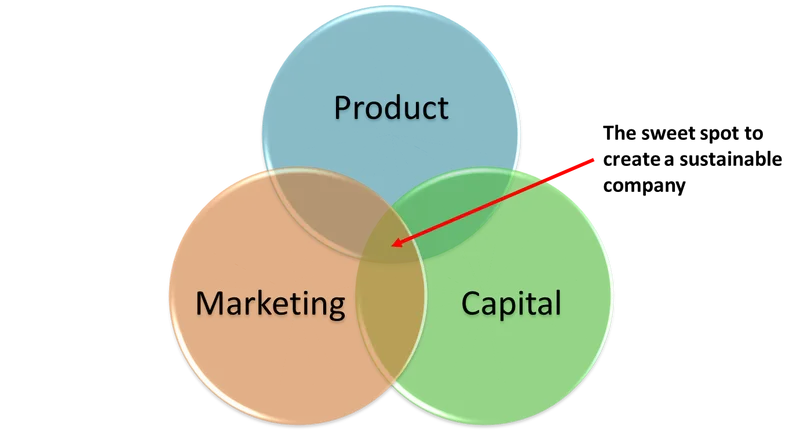3 key pillars to turn your startup into a sustainable company
Capital, Product and Marketing are the three key pillars through which a startup can become a sustainable company in the long run. Many startups end up focusing only on one or, at most, two of these pillars, which negatively affects them sooner or later.
For instance, many companies tend to focus only on raising funds and marketing, while ignoring product development. This approach will lead to your website going down when traffic is high. Even Flipkart had gone through this phase during Big Billion sales, but they have certainly been able to create a balance by scaling up their product since. This article presents an easy to understand framework for newbie founders and co-founders to build their startups.

Here is an easy to grasp Venn diagram to get a sense of what is to come in this article.

Why is this framework important?
If you ignore product development, say, by not focusing on creating a scalable backend, then your website might crash when visitors suddenly start coming in. This is what happened with Flipkart two years ago, when they first launched the Big Billion Day campaign. They have certainly brought a balance to their product since then. If you ignore marketing, then you might have a great product with decent funding, but you will end up with no users (think Google+). If you ignore capital, then you might have a good product and lot of users, but no viable way to make money; Facebook was in this position till a few years ago. Therefore, it is imperative that you understand the importance of each of these pillars and focus on building your startup for the long haul.
The First Pillar - Capital
Capital is the very life blood of a startup. You need it to survive, with even the daily, mundane activities like paying your utility bills being dependant on the presence of funds. There are three basic sources of funding, depending upon the stage your company is in:
- Self-funded: This is the money you put into the company through your own savings or money borrowed from your friends/family. You should rely on it only to build a small prototype (or MVP) of your idea. Show off your MVP to a few target customers/investors to get their initial feedback. This will help you understand whether it makes sense to continue pursuing the idea or change it completely.
- Investor funds: This can range from initial seed funding from an HNI to VC funding during Series A, B or C rounds. This money usually comes in only when your startup has already started earning its revenues from an existing set of customers. In some cases, however, investors will give you money if you have successfully exited startups earlier.
- Customers: This is the profit you generate by selling your products or services to your customers. This is the most important source of capital for your startup, and you should spend a good amount of time building up this source. If you have a B2C product, then remember that it will require larger scale to bring in sufficient money initially. So, either continue looking for an investor or tie up with other businesses for bulk deals. You need to be cognisant of the fact that even in the B2B world, the money will flow in only three to six months after the delivery of your work.
The Second Pillar - Product
Think of the product as the physical manifestation of your idea. It has to incorporate what is technically feasible. However, make sure you build your product to be flexible; don’t over-engineer for scalability in the early stages. It is once customer traction starts to build that having a scalable system, which works with minimal maintenance, takes your startup to the next level. An easy way to analyse your product is based upon the stage of your startup. Below are the key stages for a startup:
- Early Development: During this stage, you should keep your product light on features and your team agile. Do not spend months trying to build features. The key here is to talk to your potential customers and understand their pain points. At this stage, try to reuse available technical frameworks and tools off the shelf to build a small product that can be presented to a few customers.
- Product-Market fit: Here, you are playing around with multiple features, trying to see which one sticks with users. Often, this can take months if you missed doing early research into your customers’ needs. The biggest mistake here is when you discover something new about the specific market that cannot be scaled. For example, if you decide to build a hyperlocal product discovery app, then you might realise later that building and maintaining the product catalogue is a huge task in itself, making it hard to scale as fast as you had expected.
Make sure you build systems (features and processes) that allow you to listen to customers and act on their feedback quickly. For example, make it easy for them to submit product feedback. Do not hide your ‘Contact Us’ option somewhere deep in the app menu. In fact, small changes in your product like changing the colour of the ‘Buy’ button can result in you losing customers. So constantly be on the lookout for ways to understand their usage and bring down barriers.
- Growth: At this point, you have got your first 1,000 paying customers and are now aggressively marketing to widen your user base. Your product should focus on scalability and building automation for repeated manual tasks. For example, this is the right time to automate the cleaning up of logs to free up server disk space or build a tool to monitor your database connections.
This is also the time to balance the new feature releases with respect to new demands coming in from customers. You should also look into hiring top developers to build a scalable backend system.
Maturity: Your business growth has started to slow down, and no amount of marketing appears to solve it. This can happen due to changes in customer behaviour or the entry of new competition. This is the time to invest in new product lines or take your existing product to new geographies.
Now, an important question is the degree of investment you need to make in the product vis-a-vis your marketing budgets. The answer again depends upon the stage your company is in. During the early development or product-market fit stages, you should invest a larger chunk of your available resources, in terms of both time and money, into Product, with Marketing having less importance. Once you have found your right market fit, you enter the growth stage. Here, your focus must shifts towards ensuring that the product can enable user growth; hence, your investments in product development can come down, with marketing investments on the rise.
The Third Pillar - Marketing
Marketing is the reason for success in 9 out of 10 startups. So, ignore it at your own peril!
The way to measure the effectiveness of marketing is to keep track of end-user growth. For a marketplace (e.g. Amazon), there is a need to grow on another dimension - the number of sellers.
Typically, large companies try to buy one end of the marketplace to drive growth in the other. For example, both Ola and Uber spent a lot of money hiring drivers to build their supply side. Once this was done, the growth in user base was a little easier.
For edtech marketplaces, marketing can mean growth along three dimensions - Content providers (for courses), Employers (for jobs) and End-users (for course enrolments).
Now, the next question is on how you grow the user base. This is easier said than done. However, I can share a few tips for marketing your startup based upon my own learnings:
- Social media marketing (especially Facebook) is primarily good for building brand or product awareness. Do NOT use Facebook to sell your products. Instead, sell your compelling story, which people will like and share. Make sure you include elements that are entertaining; this will increase the content’s shareability.
People go to Facebook to take a break from their stressful work. So avoid putting in their way updates that add to cognitive load, like selling a product (involves price comparisons). However, if your startup is focused on entertainment, then Facebook is the best marketing tool for you!
- Invest your time in building e-mail lists of your target customers. Invest time in this activity right from day one. When sending emails to your customers, avoid adding a lot of images or videos - they make your emails look like spam and take longer to load. A good rule of thumb is to just send five or six lines of simple text with a maximum of one image or link. Use the simple and direct language that you use while talking to your friends. Once you have a sizeable customer base, look to build automation around emails to engage better with your customers, e.g. automated emails when users don’t come back to your site after two weeks.
Paid customer acquisition isn’t bad, especially if you use it to validate your product-market fit. A common myth is that customers being acquired through paid advertising is bad for startups. This is plain wrong! Customers don’t care how they came to know about your product or service. They will try out your product no matter how you reached them, whether through free emails or paid google search. Unless you have good product to sell, try to limit your paid advertising only to validate your product with the first 100 customers, especially during early stages.
(Disclaimer: The views and opinions expressed in this article are those of the author and do not necessarily reflect the views of YourStory.)







